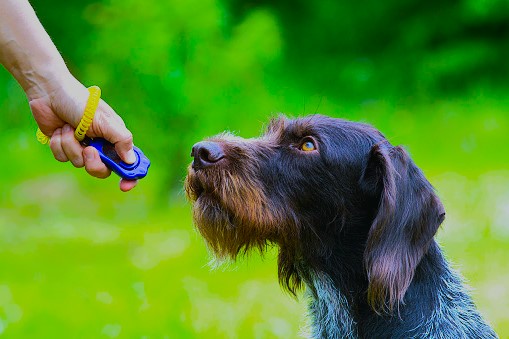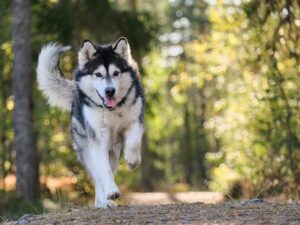Dog training is a fun experience if done right and it helps to build the bond between you and your dog. Clicker training is one of the most powerful and popular ways to train a dog. It is a method of positive reinforcement that, with the help of a small tool producing the sound clicker, marks the right behaviors so that we can teach our dogs to execute them in series.
What is Clicker Training?
dog training clicker training—clicker dog training—is a way to train your pooch that relies on a sound event at the exact moment when the dog is doing some act correctly. After she hears the click, a consequence follows right away: most commonly, a reward in the form of a treat to reinforce that behavior. The dog learns to pair the click with the reward The dog has learned that certain behaviors will earn them a click and a treat
Benefits of Clicker Training
1. Clear Communication
A clicker can provide you with a clear and consistent way to communicate with your dog. The click sound is much more precise than verbal praise, which can differ in tone and timing, so it is easier for dogs to know exactly which behavior they are doing correctly.
2. Positive Reinforcement
The clicker training rewards the right behavior instead of punishing a wrong one. Positive reinforcement helps establish a good relationship with you and your dog, based on trust and happiness. This type of training is effective, and it gets results, but once again rewards-based training achieves faster more precise results that are also ethically better for the dog as well.
3. Effective and Efficient
Clicker training is one way to do this that can be quick and relatively effective. Timing: A click is less than a second, so it helps to teach dogs new behaviors quickly and reliably. Helpful for advanced tricks and teaching a full behavior As the dog receives instant feedback, it can more easily figure out which of its behaviors are good.
4. Versatile
This way of training can be used for dogs of different ages and breeds. No matter whether you’re training for basic obedience, agility or trying to teach that one last trick that seems just beyond your dog’s ability, clicker training can be tailored to fit you and the objectives of your canine companion. It also helps with behavior training and enforces good manners.
How to Get Started with Clicker Training
1. Choose the Right Clicker
Pet stores and online have clickers for less than a dollar. Some are also likely to feature sound with adjustable volume settings for those with sensitive pooches that do not like laud music. Good ergonomics and comfort clicker, clicker MUST be something you will use consistently.
2. Introduce the Clicker
You should also introduce your dog to the clicker before you begin training. Click the device, and immediately reward your dog. Do this a few times until your dog has started to link the click with the reward. This is what we call “charging the clicker.”
3. Start with Simple Commands
Start with a simple command, such as “Sit” or “Stay.” Click the clicker and feed your dog WHEN he is doing what you want him to do. Timing should be consistent for your dog to learn the desired behavior. Use an enthusiastic tone of voice and happy body language to even more strongly encourage the desired behavior.
4. Practice Regularly
Consistency for Clicker Training to Succeed The short frequent sessions work better than the long infrequent ones. Try to train a few minutes several times a day. The key is to make the sessions enjoyable and interesting to keep your dog entertained.
5. Gradually Increase Difficulty
As your dog improves with basic commands, you can begin to increase the level of difficulty. Begin to add in new commands and behaviors, click and reward for those that are done correctly. This is where patience comes into play, make sure your dog has perfected the steps before trying anything harder.
6. Fade the Clicker
As soon as your dog can consistently produce the appropriate behavior, you must start to differentiate from making use of a clicker. You will reward the behavior, but now you will click much less often. Over time, your dog will learn to respond to his verbal cues without even needing a click. The process is designed to be gradual, so you should also transact this way in order for your customers to avoid confusion.
Common Mistakes in Clicker Training and How to Avoid Them
1. Inconsistent Timing
Clicker training works on the principle of consistency. Make that click precisely when your dog is in the act of doing what you like. Time it wrong and you may reward your dog for biting! File it down, time your craft rulings
2. Overusing the Clicker
The clicker is a potent tool; however, using it too reliantly can reduce effectiveness Click ONLY when the dog does something you ARE using as a command to reinforce. Do not click for anything or for behaviors you do not want to be associated with the reward.
3. Ignoring Small Successes
Celebrate small victories. This is a long-term process, and any minor successes on the path to that behavior should be clicked and treated. The following mixed trick list can show your dog that they are able to trust themselves and be great learners.
4. Not Phasing Out the Clicker
Once the dog is listening to verbal commands without hesitation, then you phase out the clicker. Then, slowly wean it out to use the clicker less and things like verbal praise and treats more for reinforcement. Ensuring the changeover is simple, and make sure not to confuse your pet.
Tips for Successful Clicker Training
- Be Patient: Every dog will learn at their own pace. Have patience and do not be discouraged by a dog who does not get it quickly. Celebrate small steps and always keep your sessions positive.
- Keep it Positive: Reward Desired Behavior Instead of Punishing Missteps. This will help keep your dog motivated and willing to learn. Driving this a little further, positive reinforcement enhances the relationship you have with your dog.
- Stay Consistent: Consistency is going to be your best friend when it comes to training. Observe the training videos and mimic the commands, click at the same place in the behavior, reward with those treats. Regular training routines teach your dog how to behave.
- Have Fun: Your training should be a fun and positive experience for both you and your dog. Give me good vibes and end it off nicely. Dogs that are happy learners.
Conclusion
Using positive reinforcement as a way of training your dog is one of the most humane alternatives. With some clear communication, and using treats to reward good behaviour, you will begin teaching a suite of commands and tricks and building a strong bond with your dog, where they trust in you. Clicker training is the nest big thing in dog training, and as either a first time pet owner or an experienced canine trainer, this method really gives you an easy and effective way of working with your dog.




